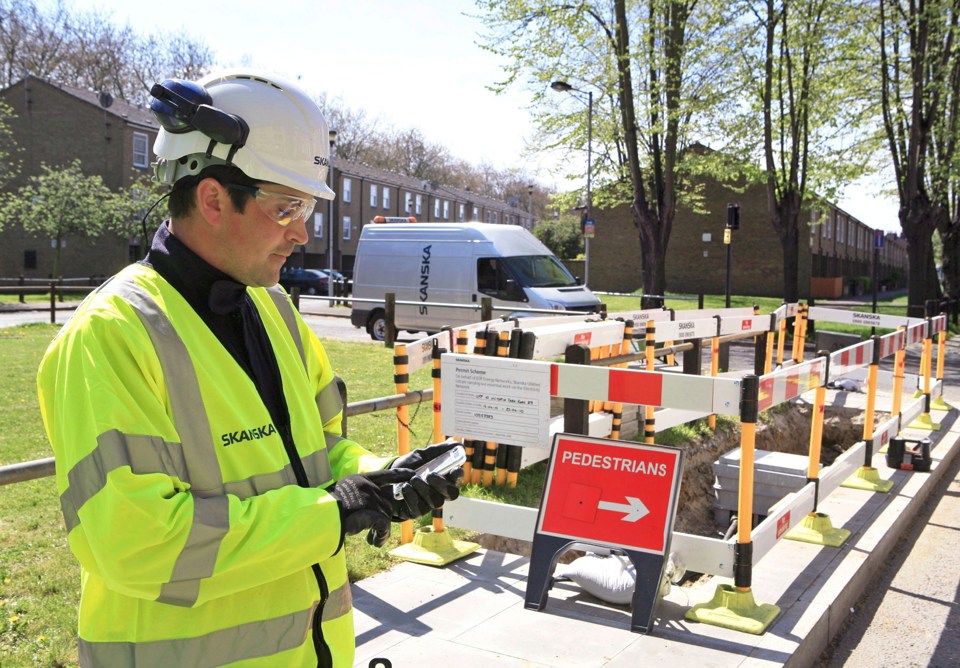Project development and construction company Skanska UK is building a multi-award-winning reputation for its fleet safety and now the business is passing its expertise on to its supply chain and a wide range of other organisations.
Skanska UK fleet risk and compliance manager Alison Moriarty has led the implementation of a multi-faceted occupational road risk management strategy that, in many cases, goes beyond the legal limit, notably in respect of the company’s drugs and alcohol policy and van drivers’ hours.
Now Skanska is using its knowledge and experience gained in creating a robust work-related road risk policy to help clients and its entire supply chain to introduce similar measures to make the UK’s roads safer, including sitting on a number of companies’ fleet safety committees.
Skanska’s focus on occupational road risk management led to it adding to its list of awards with the Safe Commercial Fleet of the Year title in the 2016 Commercial Fleet Awards.
The judges said: “With a professional approach to managing risk within the commercial vehicle environment, Skanska’s emphasis on training and awareness shows strong evidence of robust and well thought-through policy and governance. A stand-out winner demonstrated by a multi-faceted approach to management safety and risk.”
Publicity resulting from such award wins invariably generates enquiries from other organisations for help and advice, according to Moriarty, who joined Skanska three-and-a-half-years ago in the newly created role.
“It’s always nice to be recognised and when we receive recognition we are contacted by other businesses wanting advice and information,” says Moriarty. “We are passionate about helping people because, if their fleet is safe, our fleet and the roads will be safer.”
Skanska UK, which operates a fleet of 600 LCVs and 257 HGVs and specialist vehicles, is known for working on major London construction projects such as the Gherkin, Crossrail and the redevelopment of the Battersea Power Station site.
Ethical approach
Moriarty says: “Skanska has a strong ethical approach and is committed to improving road safety in any way it can. We believe that, as a large company, we have a duty to try to help and influence as many companies as possible, including our clients and supply chain.
“It is our responsibility to ensure that every person who works for Skanska returns home safely at the end of the working day.”
A member of the Freight Transport Association’s Van Excellence initiative, the Fleet Operator Recognition Scheme (FORS), the Construction Logistics and Cyclist Safety (CLOCS) programme and the Chartered Institute of Logistics and Transport, Skanska is represented on governance and road safety groups of each as the company helps to shape best practice.
Additionally, Skanska is a Driving for Better Business (DfBB) campaign ‘business champion’ and Moriarty recently attended a ‘Driving for Work Summit’, hosted by the team behind the programme, which aids the Department for Transport’s ambition to support and promote good practice in safer fleet management and occupational road safety.
Rickmansworth-headquartered Skanska also works closely with road safety charity Brake and last year road safety was a focal point of Skanska’s internal ‘Injury-Free Environment’ programme.
Moriarty, who was named Road Risk Manager of the Year at the 2015 and 2016 Brake Fleet Safety Awards, says: “We are proactive in sharing best practice by engaging with other companies and organisations.
“We believe it’s really important to be involved with initiatives such as Van Excellence, FORS and CLOCS because they lay down an industry minimum standard. At Skanska we always try to exceed the minimum, but at least working to the criteria ensures fleets are operating to a recognised safe and legal standard.”
To that end, Skanska UK has, since September 30, 2015, required all suppliers delivering in Greater London (including the M25) to be accredited to the FORS Silver Standard. In addition since the same date last year, all suppliers have been required to hold UK-wide FORS Silver accreditation – or have a plan in place showing how it would be achieved within 12 months.
Skanska, which is working towards whole fleet Silver and then Gold Standard accreditation, also asked its supply chain to sign up to the CLOCS memorandum of understanding to show their commitment to that standard and the measures to be taken to improve road risk management.
Furthermore, the company has encouraged all contractors to actively work towards FORS Gold in a bid to continually improve the management of road risk within the construction industry.
Moriarty, who reports to Skanska head of fleet Julie Madoui, says: “We work collaboratively with our supply chain partners to fully integrate the highest possible safety standards, everywhere we work. Ensuring that they achieve FORS Silver accreditation provides us with confidence that our suppliers are working to the same standards as Skanska.
“FORS actively promotes and shares best practice, and provides training and tools for all industries involved in road transport to continually improve upon road safety for the benefit of all road users.”
Skanska classifies commercial driving as a “safety-critical activity” and, in respect of drug and alcohol use, believes drivers at the current legal limits could have their concentration and thinking skills adversely affected.
Moriarty says: “We have moved beyond compliance and are aiming for excellence as we believe that legal doesn’t always mean safe.”
In setting its own tougher standards – while allowing for any possible medical need in respect of drug use – Skanska’s policy also includes the right to test post-collision, randomly and with just cause anyone who drives a vehicle in connection with the company’s business. This includes contractors, sub-contractors, consultants and agency workers.
Moriarty joined Skanska from support services company Enterprise where she was group health and safety manager for five years, latterly a role that also embraced fleet risk. “Fleet risk is at the top of the health and safety agenda and there is a very real collaborative approach between the fleet and health and safety teams,” she says.
What’s more, the raft of work-related road safety initiatives introduced by Skanska has resulted in a business-wide spread of awareness of the importance of fleet risk management from drivers to managers and directors.
A fleet steering group comprising decision-making representation from a wide cross-section of company departments, including operations and HR, ensures initiatives are introduced rapidly as they receive immediate focus and buy-in.
“Skanska is on a journey to an injury-free environment,” says Moriarty, who adds that all health and safety advisors and managers had undergone training to better investigate road traffic collisions.
Skanska records every vehicle-related incident no matter how small and in the past two years has seen the number of own-fault van incidents fall from 34% to 21% and the number of own-fault truck incidents fall from 27% to 16%.
Moriarty, who has spent her career in health and safety including at Lancashire County Council, says: “The collision statistics are encouraging and provide demonstrable evidence that we are helping to make the roads safer for all road users.”
The work undertaken by the fleet team has resulted in reduction in insurance premium savings totalling almost 19% in recent years.
Skanska’s holistic approach to improving driver safety and its understanding of the risks involved when behind the wheel of a commercial vehicle – the company also has almost 2,600 company cars/car allowance drivers – starts with online risk assessments that include hazard perception and attitudes to driving and licence checks.
CV drivers get individual ‘risk ratings’ which are reduced as they complete training modules for areas of improvement identified following completion of the online risk assessments.
All drivers undertake a driving assessment on employment – under the eagle eye of one of eight Skanska transport managers all of whom are qualified driving assessors. Forming part of their induction process, any shortfall in standards in terms of skill or attitude could result in induction process failure. Furthermore, such assessments are repeated throughout a driver’s employment.
All CV drivers have their licences checked quarterly against the Driver and Vehicle Licensing Agency (DVLA) database and endorsements are monitored by the fleet team and cascaded down to managers and drivers. Additionally, any notices of intended prosecution are treated similarly.
The company’s comprehensive driver training programme focuses on driver behaviours and the safety of vulnerable road users – pedestrians, cyclists and motorcyclists who are statistically the most likely people to be killed or injured on the roads per billion miles walked or travelled.
All HGV drivers take a FORS ‘safe urban cycling’ course and Skanska adopted the online cycle safety training for delivery to van drivers.
Skanska also recognises what it calls the “disparity between the heavily regulated HGV driving sector and other commercial drivers”. It ensures van drivers are subject to identical mandatory continuous rest periods according to European Union rules, thus guarding against fatigue.
What’s more, training sessions are delivered to operational senior managers to help them better understand their responsibilities in managing fleet and driver safety and have comprehensive knowledge of applicable legislation.
To that end, all Skanska transport managers and virtually the entire fleet team have become FORS Practitioners after completing a series of workshops covering all aspects of fleet management including managing work-related road safety, safe and efficient fleet management, reducing fuel use and minimising fines and charges to help them implement safer, greener and more efficient transport procedures.
At the heart of the management of Skanska’s occupational road risk management strategy is sophisticated IT embracing fleet and asset management software company Jaama’s Key2 Vehicle Management system and TomTom Telematics’ Webfleet platform.
Key2’s driver risk assessment module is used to manage and monitor driver risk levels and licence checks, record all incident and fines data and deliver a one-stop record of all driver training including the compilation, as required, of bespoke reports for individual business units and internal benchmarking on a per contract basis.
“These reports can be high-level for senior management showing trends and progress, while low-level reports can be produced for individual contracts,” explains Moriarty.
Skanska’s return on investment focus is further enhanced by the ability to produce management reports showing the cost of incidents, vehicle downtime reductions, fuel-saving improvements and fleet maintenance cost savings notably in respect of wear and tear parts, which, says Moriarty, “highlighted the reasons to push for a safer fleet; something that is highly effective in a commercial environment”.
Trigger for training
The module monitors drivers’ ‘risk ratings’ daily, updating scores based on the previous day’s returns from licence checks, fines, completed training etc and also acts as the trigger for additional behavioural training if risk levels increase.
Allied to Key2 has been the fitment of telematics into CVs and the use of the Webfleet platform that aids vehicle tracking, fleet optimisation, workforce management and safe and green driving including driver behaviour and fuel monitoring.
The roll-out of telematics is continuing as commercial vehicles are renewed with approximately 25% of the fleet currently equipped. CVs are leased or bought subject to the requirements of individual business contracts won by Skanska, which means replacement cycles vary hugely.
Telematics data is only relevant if it is managed, interpreted and acted upon. To that end, the business-wide fitment of vehicle telemetry has seen at least one ‘responsible person’ per Skanska contract trained to monitor the risk data emanating from the system – including notification of speeding, harsh driving and driving time.
Moriarty says: “These employees are well positioned to know the drivers and deal with any issues, or praise best practices, as and when it is needed. That means the central fleet department is free to focus on wider trends and strategies.”
Additionally, this year Matt Burridge has been appointed telematics manager in a seven-strong fleet administration and risk team reporting to Moriarty. The fleet department numbers 13 – to oversee the data and compile bespoke reports.
“The data enables efficiencies to be driven across the fleet in respect of highlighting fuel and maintenance savings because employees are driving more smoothly. That is also reflective of a safer driving style,” she says.
Skanska also won last year’s Fleet News Safe Fleet of the Year Award and is a perennial winner of health and safety awards from the Royal Society for the Prevention of Accidents (RoSPA).
A new Fatigue Management Group has been launched across Skanska, which is investigating issues around driver tiredness and how to alleviate it, while an employee mental health programme has also been developed.
“Employees are individuals and it’s important they are as happy and healthy as possible. If people are unwell or unhappy it can impact on their work and potentially affect their ability to concentrate which can be dangerous when driving,” explains Moriarty. She says the safe driving focus was increasingly embracing employee health and well-bring that could include specific features added to vehicles to accommodate individual employee requirements.
“It is easy to vilify drivers if they do something wrong, but it could be the result of a management issue or something in their personal life that made them behave the way they did,” says Moriarty.
Adding that communication was key and that most employees wanted to drive safely, Moriarty concludes: “How driving safely influences employees in their personal life is an effective way of getting the safety message across.”
Road safety close to magistrate Moriarty’s heart
Passionate about road safety in the work place, Alison Moriarty brings a different perspective to her job as Skanska’s fleet risk and compliance manager because she has spent more than 14 years as a magistrate.
Initially on the Preston bench and now on the Swansea bench where she lives, Moriarty, reflecting on the heartache and devastation that poor driving decision-making can bring, says: “Road safety is something that is very close to my heart. As a magistrate I see first-hand what happens when a driver’s decision-making goes wrong.
“People do some ridiculous things when they are driving. The devastation that the outcome of what they do causes has a huge ripple effect across family, friends and colleagues.”
That’s why Moriarty says: “Some things are not illegal, but it does not make them safe.”
That is the sentiment behind Skanska’s introduction of a drink- and drug-driving policy that is tougher than the law and why the company’s van drivers are subject to the same drivers’ hours policy and rest periods as those behind the wheel of larger commercial vehicles.
It’s also why Moriarty, who wants to see a tightening of the drink-drive limit in England and Wales, has her sights set on a potential complete ban on all mobile phone use while driving.
She says: “We encourage drivers not to use their hands-free phones while driving. We don’t want people to have conversations while driving because that is a distraction. It is not illegal to use a hands-free phone, but that doesn’t mean we don’t want to discourage all use.”

















Login to comment
Comments
No comments have been made yet.